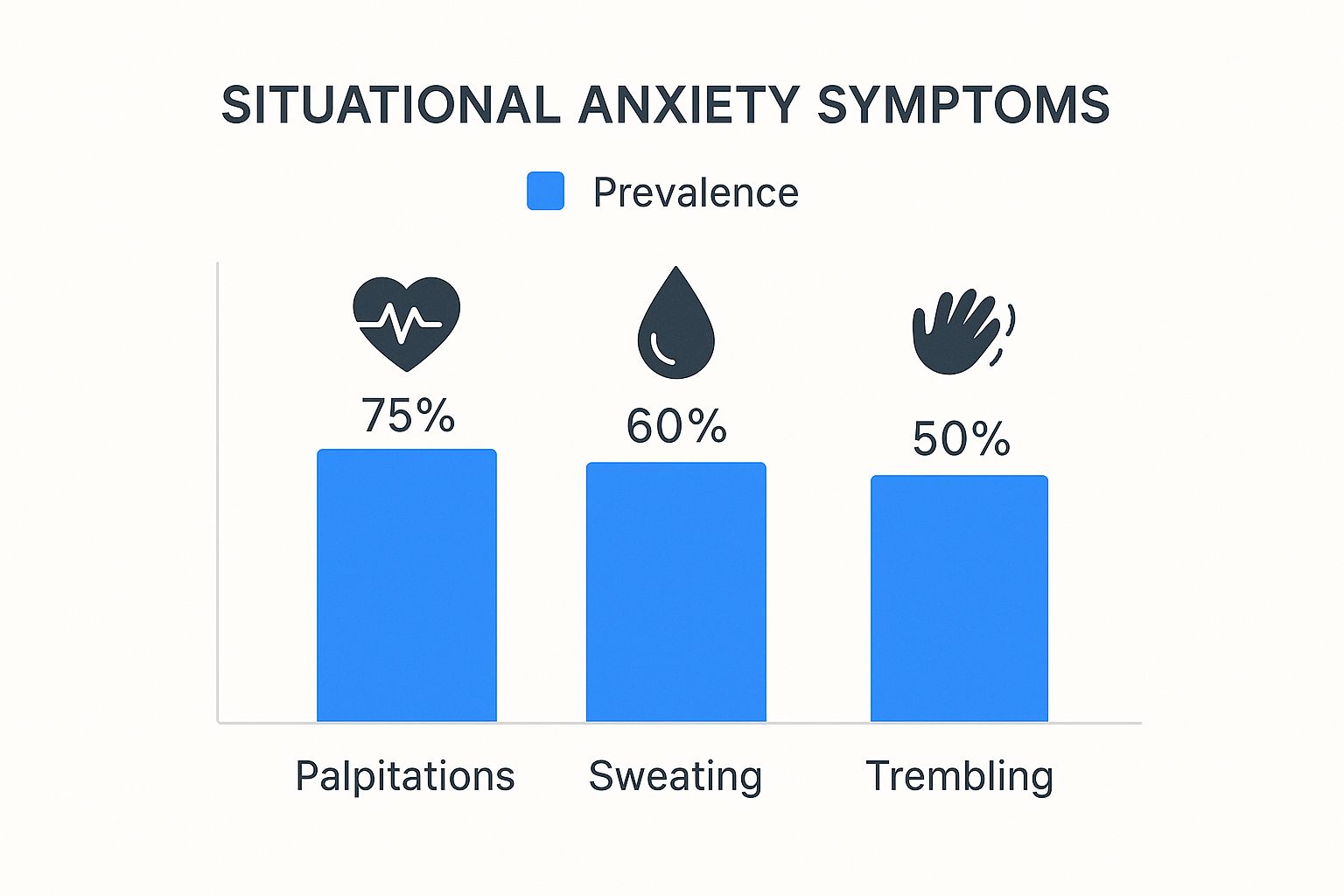Feeling intense fear in specific situations is a common human experience. It's not a constant worry, but a powerful reaction tied to certain triggers, like public speaking or flying. In the medical world, this is often classified using the situational anxiety ICD 10 code, specifically F40.24 (Situational Type Phobia). This code helps professionals communicate clearly to provide the best support for your well-being.
Understanding Situational Anxiety and Its Classification

It’s one thing to feel nervous before a big meeting, but situational anxiety is much more intense. It’s an overwhelming wave of fear linked to a particular circumstance. You might feel calm most days, but the thought of getting into a crowded lift or crossing a high bridge can trigger powerful physical and emotional responses.
This is a recognized mental health challenge, not a personal flaw. Its key feature is predictability; unlike general anxiety that can feel vague, situational anxiety is focused on specific triggers. This focus makes it easier to identify and manage with the right therapy and counselling.
The Role of ICD-10 in Your Well-being Journey
So, what is the International Classification of Diseases, 10th Revision (ICD-10)? Think of it as a universal health dictionary used by doctors and therapists everywhere, from Delhi to New York. This system ensures everyone speaks the same language about health conditions.
Using this system is an important first step on your path to feeling better. It ensures your experience is understood correctly and helps you access the right kind of support, from effective therapy to potential insurance coverage for your treatment.
Why a Specific Code Matters
Having a precise code like F40.24 for situational phobias is more than just paperwork. It makes a real-world difference in your care.
- Clarity in Assessment: It helps your therapist understand the exact nature of your anxiety, distinguishing it from other conditions like generalised anxiety or depression.
- Tailored Support Plans: A clear assessment allows professionals to create a support plan that addresses your specific triggers, often using proven methods like therapy.
- Access to Resources: This formal classification validates your experience and opens doors to professional mental health services and resources designed for your needs.
In India, anxiety disorders are quite common, and understanding the situational anxiety ICD 10 classification helps shape how your challenges are understood and managed. For more clinical details, you can explore information about ICD-10 codes for specific phobias.
How Clinicians Use ICD-10 Codes for Anxiety
An ICD-10 code is like a universal shorthand in healthcare, ensuring every professional involved in your care is on the same page. In India's healthcare system, these codes are practical tools that bring clarity to your mental health journey.
When a professional uses a code like F40.24 for situational anxiety, it helps them create a personalized support plan and points toward the most effective therapy or counselling. This connects your personal experience to a recognized framework, paving the way for targeted and helpful support.
A Framework for Understanding and Support
The code for situational anxiety belongs to a larger family of classifications. For instance, the F40 category covers phobic disorders, while F41 is for other anxiety disorders. Knowing this helps you and your therapist see the bigger picture of your mental well-being.
This system helps demystify medical jargon, showing that these codes are simply tools designed to bring order to the process. Their purpose is to connect you with the support you need, whether for managing workplace stress or building emotional resilience.
The International Classification of Diseases, 10th Edition (ICD-10) system plays an essential role in understanding anxiety in India, facilitating uniform documentation and policy-making. This framework supports care and helps measure therapeutic outcomes, especially for providers focusing on situational anxiety.
To help you get a clearer picture, here's a look at some of the common codes related to anxiety.
Common ICD 10 Codes Related to Anxiety
This table breaks down key ICD-10 codes to help you understand the classification system. Remember, this is for informational purposes and not a substitute for a professional diagnosis.
| ICD 10 Code | Diagnosis | Common Examples or Triggers |
|---|---|---|
| F40.00 | Agoraphobia without panic disorder | Fear of public transport, open spaces, or being in a crowd |
| F40.10 | Social phobia, unspecified | Intense fear of social situations, public speaking, or being judged |
| F40.248 | Other specific phobia | Fear of specific situations like flying, heights, or enclosed spaces |
| F41.1 | Generalised anxiety disorder | Persistent and excessive worry about various things (work, health) |
| F41.9 | Anxiety disorder, unspecified | Symptoms of anxiety that don't fit into a more specific category |
Understanding these codes shows how specific an assessment can be, which is crucial for getting the right kind of help.
From Assessment to a Path Forward
The real value of ICD-10 coding lies in its precision. To use a code, clinicians must document the specific situations that cause anxiety, like a fear of flying, and note the severity of your symptoms. This detail ensures your care is matched to your unique needs.
As mental health awareness grows in India, standardized coding helps healthcare systems track trends and refine treatments for conditions like anxiety and depression. It's important to remember that these assessments are informational tools, not permanent labels. They are the start of a supportive journey toward building resilience and finding balance.
Recognising the Symptoms of Situational Anxiety

Let's talk about what situational anxiety actually feels like. Spotting the signs in your mind and body is the first step toward building resilience and finding the right support. This is about gently recognizing patterns with self-compassion, not labeling yourself.
These feelings are valid responses to overwhelming situations. Acknowledging them is important because they are often your mind's way of suggesting it might be time to look into counselling or therapy.
Physical Sensations: When Your Body Goes on High Alert
Often, the first sign of situational anxiety is physical. You might notice your heart pounding, hands trembling, or a tightness in your chest that makes it hard to breathe. This happens when a specific trigger puts your body on high alert.
Some people feel dizzy or lightheaded, while others experience a churning stomach. These are not random; they are your body's natural alarm system reacting to a perceived threat, even if that threat is a crowded metro in Mumbai or a looming deadline. This is a common human reaction, not a sign of weakness.
Emotional and Mental Signs: The Internal Storm
Beyond the physical feelings, situational anxiety can create an emotional storm. You might be hit with a sudden wave of dread or a sense of doom. Your thoughts may start racing, focusing on worst-case scenarios and making it hard to concentrate.
This mental whirlwind can be draining and contribute to long-term workplace stress and even burnout. It's normal to feel irritable or overwhelmed, which can impact your overall well-being and happiness.
A key feature is "anticipatory anxiety," where fear begins long before the event. Just thinking about an upcoming flight or presentation can trigger a strong reaction, trapping you in a cycle of worry.
Behavioural Changes: The Powerful Urge to Escape
One of the most telling signs is a change in your behavior. Situational anxiety creates an intense urge to avoid the triggering situation. If you fear public speaking, you might turn down a promotion to avoid presentations.
While avoidance offers temporary relief, it can strengthen the anxiety over time, limiting your personal and professional life. Recognizing this instinct is a huge step. With professional guidance, you can learn healthier ways to manage anxiety and depression without putting your life on hold. These observations are a starting point for self-awareness, not a diagnosis.
Situational Anxiety vs Other Anxiety Disorders
Understanding your feelings is the first step toward managing them. While many experiences fall under the umbrella of "anxiety," different types function in unique ways. Knowing the difference is key to finding the right path forward, whether through self-help or professional therapy.
Situational anxiety is linked to a specific, identifiable trigger. In contrast, Generalised Anxiety Disorder (GAD) is more like a constant, low-level worry about many different things, making it difficult to relax.
Pinpointing the Core Differences
The core difference between these conditions lies in the source of the worry and how long it lasts. This clarity is very helpful when speaking with a professional, as it guides them toward the most effective counselling for your needs.
This infographic shows how common certain physical symptoms are when situational anxiety hits, highlighting the intense bodily reaction to a trigger.

As you can see, heart palpitations are a very common response. This reminds us how powerfully our minds and bodies are connected when we face a feared situation and how these triggers can affect our physical well-being.
Situational Anxiety vs Other Anxiety Types
This table can help clarify the differences between these conditions. Remember, this is an informational guide, not a substitute for a professional assessment.
| Feature | Situational Anxiety (Specific Phobia) | Generalised Anxiety Disorder (GAD) | Social Anxiety Disorder |
|---|---|---|---|
| Primary Fear | A specific object or situation (e.g., flying, heights, enclosed spaces). | Persistent, excessive worry about multiple things (e.g., health, work, family). | Fear of being judged, scrutinised, or embarrassed in social situations. |
| Trigger | Direct exposure or anticipation of the specific trigger. | Chronic and often free-floating; not tied to one specific thing. | Social or performance-based situations (e.g., meetings, parties, eating in public). |
| Duration of Worry | Intense but generally limited to the time around the trigger. | Occurs more days than not for at least six months. | Persistent fear related to upcoming social events or interactions. |
| Main Focus | Avoiding the phobic trigger to prevent intense fear and panic. | Managing uncontrollable worry and its physical symptoms, like fatigue. | Avoiding social situations to escape judgement and embarrassment. |
Recognizing these distinctions can be empowering. It helps you name what you're feeling and describe it more accurately, whether you're navigating workplace stress, feelings of depression, or a specific fear.
Building Resilience to Manage Anxiety
Understanding situational anxiety is a great first step; the journey is about building your inner strength. Think of resilience as a muscle that gets stronger with practice. It helps you navigate life's challenges, including intense anxiety, with more balance and self-compassion.
By equipping yourself with practical strategies, you can begin to manage the emotional and physical toll of anxiety. These tools can empower you to face triggers with more confidence and improve your overall well-being.
Practical Strategies for Building Inner Strength
One of the most effective tools is Cognitive Behavioural Therapy (CBT). This type of therapy helps you identify and reframe negative thought patterns that fuel anxiety. A therapist can also guide you through exposure therapy, where you gradually face your triggers in a safe, controlled way to build confidence.
Mindfulness and deep-breathing exercises are also wonderful for calming your nervous system in the moment. Simple techniques can ground you, slow your heart rate, and bring a sense of calm. These practices are also great for managing chronic workplace stress and preventing burnout.
"The greatest weapon against stress is our ability to choose one thought over another." – William James
This quote captures the essence of building resilience. We can't always control external events, but we can learn to manage our responses. If you’re looking for more ways to support your journey, you might find it helpful to explore some therapeutic activities for mental health that can help nurture your mind.
Your Path to Greater Well-Being
Creating a personal toolkit for managing anxiety is about self-discovery and kindness. It involves finding what works for you and weaving small, positive habits into your daily life.
- Mindful Moments: Start with just five minutes of mindfulness meditation each day to train your focus and quiet your mind.
- Physical Movement: Regular exercise, even a short walk, is a proven way to reduce symptoms of both anxiety and depression.
- Professional Support: Working with a counselling professional provides a safe space to explore your fears and develop coping strategies tailored to you.
Remember that any online tools or assessments are for informational purposes only and are not a substitute for a professional diagnosis. The goal is to provide supportive takeaways that empower you to handle life's stressors and build a happier, more resilient life.
Final Thoughts on Your Path Forward

As we conclude, let's focus on the supportive steps you can take from here. By seeking to understand your anxiety, you've already taken a courageous step toward self-care.
Reaching out for help is a sign of strength. Using tools like the situational anxiety ICD 10 code helps professionals provide the right support and clear the way for effective therapy.
Embracing Your Unique Journey
Your mental health journey is unique. Some days will be easier than others, and that is completely normal. The goal isn't a "cure," but the steady process of building resilience and self-awareness.
Think of professional counselling as a safe space to explore your feelings and learn practical ways to cope with workplace stress, anxiety, and depression. A therapist can act as an experienced guide on your path.
Managing anxiety is a journey, not a destination. Every step you take, no matter how small it feels, is a win. You're building a more balanced, fulfilling life, and your commitment to yourself is the most powerful tool you have.
Gentle Reminders for the Road Ahead
Treat yourself with the same kindness you would offer a friend. Acknowledge your progress and be patient with yourself during difficult moments.
- You're not alone: Millions of people experience anxiety. Knowing this can reduce feelings of isolation that often accompany the struggle.
- Support is available: Professional help is more accessible than ever. Platforms like DeTalks connect you with skilled therapists who understand.
- Your well-being matters: Prioritizing your mental health is essential for being present in all areas of your life, from work to relationships.
We hope you feel more informed, empowered, and a little less alone. With a clearer understanding of situational anxiety, you are better equipped to find the right support and move toward a life with more peace and happiness.
Frequently Asked Questions
It's natural to have questions as you navigate your mental health. Here are answers to some common queries about situational anxiety to provide more clarity on your journey to well-being.
Is Situational Anxiety a Recognised Medical Condition?
Yes, it is. While we may call it "situational anxiety" in daily conversation, the medical community formally classifies it within the situational anxiety ICD 10 framework. In this system, it is typically categorized as a specific phobia.
This recognition validates your experience and is understood by doctors and therapists in India and globally. It also opens the door to effective support, such as targeted therapy and counselling, to help you manage your specific triggers.
How Do I Know if I Need Therapy for My Anxiety?
This is a personal question, but a good guideline is to consider its impact on your life. Is anxiety stopping you from doing things you enjoy or holding you back from professional or social opportunities?
If you feel you are constantly battling distress from workplace stress or fear, professional support can make a significant difference. Counselling offers a confidential, non-judgmental space to explore these feelings and build resilience with practical coping strategies for anxiety or feelings of depression. Reaching out is a powerful step toward taking back control.
Can Situational Anxiety Get Better?
Yes, absolutely. With the right support, people can learn to manage situational anxiety and reduce its impact on their lives. There is every reason to be hopeful.
Therapies like Cognitive Behavioural Therapy (CBT) have proven to be very effective. They help you challenge the thoughts that fuel fear, allowing you to gradually and safely face situations you once avoided. The goal is to build your confidence and skills so that anxiety no longer controls your life, empowering you to live more fully.
At DeTalks, we can connect you with experienced professionals ready to support you on this journey. If you're ready to take the next step, you can explore our network of therapists today.





